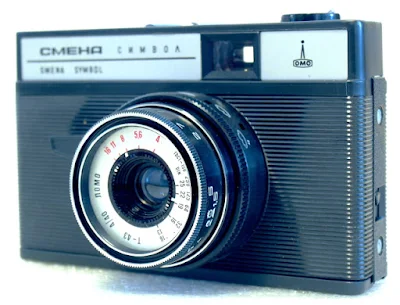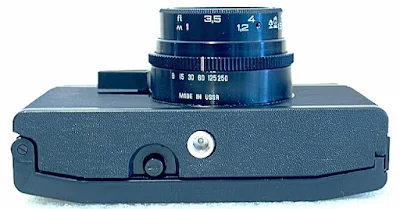The Vintage Enthusiast: A full-frame fully manual Russian LOMO 35mm film camera with a sharp Triplet-43 40mm F4 lens.
As part of my collection of LOMO 35mm film cameras, I ended up with a Smena 8M, a pair of Smena 35s, and this Smena Symbol. One of the Smena 35s is a new unused copy, the other comes in a roughed-up box with its mechanicals a bit stiff. The Smena 8M is a good-conditioned copy that was CLA's before being put online, and as far as I can attest, it works like a Swiss watch.
The Smena Symbol, on the other hand, was the surprise. While the camera box is tattered almost to its breaking point, the leather case that the camera was in was still spick and span and shows hardly any wear. Despite its age, the camera looks as though it has never been used at all, and works like a charm
The fully manual 35mm viewfinder camera was in production from 1971 to 1991 and comes with a quick cocking version of the Smena series with its shutter cock mechanism coupled to the single stroke film advance. It has a hot shoe, but no cable release socket. The plastic and metal brickbat design is bigger and heavier, at 362 grams when compared to the 289 grams weight of the Smena 8M.
Common to all the Smena's is the built-in 3-element Triplet-43 40mm F4 kit lens, which is acknowledged for its sharp image quality. The lens is fitted with a 3-blade diaphragm shutter, a shutter speed range from 1/15 to 1/250 second, including B, and an aperture opening from F4 to F16.
The lens is the same as found on Smena 6, 7, 8, 8М, Smena-Rapid, Smena-SL, Smena-Symbol, Smena-19, Smena-E, Smena-20, and Smena-35.
Lomo Smena Symbol 35mm Camera Review
This is my full review on the Lomo Smena Symbol 35mm film camera. My LOMO Home - http://www.lomography.com/homes/ajagee24701 DISCLAIMER: This video and description contains affiliate links, which means that if you click on one of the product links, I'll receive a small commission.
As a look back at its history, Smena cameras are a long series of low-cost 35 mm film cameras manufactured in the Soviet Union by the LOMO factory from 1953 to 1991. Manufactured by the millions, their main body parts are mostly of bakelite or black plastic.
Model Variation
As normal with Soviet-made cameras, the Smena Symbol also appears in various iterations during its production run. Model numbers vary from PK3705 for the original version that was announced in the early '70s, to PK7380 for the rarest version of the Symbol series, which was an exclusive export version carrying the 'Panorama' brand.My unit is most likely the domestic PK3740 model, which came with black screws on the top plate, white markings on the film memo disk on the camera backplate, a 'MADE IN USSR' stamp on the base of the lens housing, and a serial number #89xxxxxx stamped on the bottom plate.
Basic Camera Features
The simple rectangular front plate of the camera is adorned with a burnished aluminum plate with the camera name and logo across the top of the camera body, separated into two about a third way to the left by the viewfinder window. Almost central to the lower part of the front plate is the built-in kit lens assembly which incorporates all the mechanical and moving parts of the shutter, aperture, and focusing mechanism for the camera's operation.Surrounding the recessed front element of the T-43 is a rotatable ribbed ring with two fixed indentations, one pointing to the aperture scale setting and the other to the GOST-ISO/DIN film sensitivity scale. The whole of this fixture is actually located inside the rotating focusing ring, which makes for the assembly of the forwardmost part of the lens.
Focusing distances on the Smena Symbol are in Feet and Meter distances as well as distance graphic icons for portrait, group, and infinity settings.
The shutter release is by way of the lever protruding from the base of the lens housing on the left of the front panel of the camera. Press this lever for the wonderful sound of the shutter release.
The top plate of the camera is a simple flat surface, indented only by the hot-shoe mount and the film rewind crank. Settings for shutter speed and focus distances are easy to read as you look down the front of the camera.
The slightly beveled ends of the backplate of the camera are covered by the whole film back itself on the lower portion, while the upper part carries the viewfinder window, film frame counter, and film forward crank. The film back, which is fitted with a film memo disk, is opened by a simple latch lock located on the lower left shoulder of the camera body.
Different from the Smena 8M or Smena 35, the Smena Symbol does come with a film rewind release button, located on the bottom plate of the camera body. A cast-metal tripod socket is also available on the bottom plate.
The film box of the Smena Symbol is the standard manual load system as found on most 35mm film cameras of that era. You need to insert the end of the film tab into a slot on the film take-up spool and make sure that the film perforations are engaged fully with the sprocket gear before closing the film back.
The Smena Symbol does not have strap lugs on the camera body and is sold as a kit complete with a strapped leather case with the top half permanently fixed to the lower. While carrying the camera hanging from your neck or shoulder with the case dangling open could be a bit of a nuisance, your alternatives are either the camera bag or purse.
Viewfinder Readout
The viewfinder of the Smena Symbol is a simple plane glass light tunnel, shaped to approximate the 3:2 image aspect viewing angle. The viewfinder does not have any bright frame or parallax correction lines.GOST-ISO / DIN / ASA / Aperture Conversion
 |
| As seen on the Smena 35 |
On the Smena 35 (see image), the setting for a film speed of ISO 400 is equated to the aperture opening of F16, ISO 200 to F11, ISO100 to F8, ISO 50 to F5.6, and ISO 25 to F4.
It is a fact that negative film has a wide range of exposure latitude, so shooting with the film ASA speed slightly off the exact setting does not actually do any harm to the exposure. It could even be the opposite, where a touch of overexposure can actually help ensure a good result.
GOST-ISO
|
DIN
|
ASA
|
Aperture
|
16
|
13
|
25
|
F4
|
32
|
16
|
50
|
F5.6
|
64
|
19
|
100
|
F8
|
125
|
22
|
200
|
F11
|
250
|
25
|
400
|
F16
|
Using the Camera
Being an all-manual camera, operating the Smena Symbol is simple and straightforward. You are ready for the fun once you have loaded the film, set your current film speed to the GOST-ISO dial on the face of the lens (which will also set the aperture opening setting), and done the two blank shots to bring the film to frame 1.Once the aperture and shutter speed are set, adjust the focus distance to the subject based on distance measurement or estimate or by using image icons by rotating the forwardmost part of the lens. Lastly, frame the image through the viewfinder, press the shutter release and you're done.
Here's the refresher - set the aperture of the lens based on the film ISO speed you use, adjust the shutter speed according to the ambient lighting condition and you are never far off from getting the perfect exposure. It has never been easier.
A more adventurous option is to work around the camera's aperture setting for more creative effects. You can, for example, use a large aperture (F4) for close-ups with a more blurry background, a smaller aperture (F16) for greater depth of field, or an all-in-focus shot of the landscape.
Remind yourself that for each step that you enlarge the aperture (say, from F5.6 to F4), you should also increase the shutter speed (from 1/30 to 1/60) to compensate for the increased light, and vice versa.






















No comments:
Post a Comment